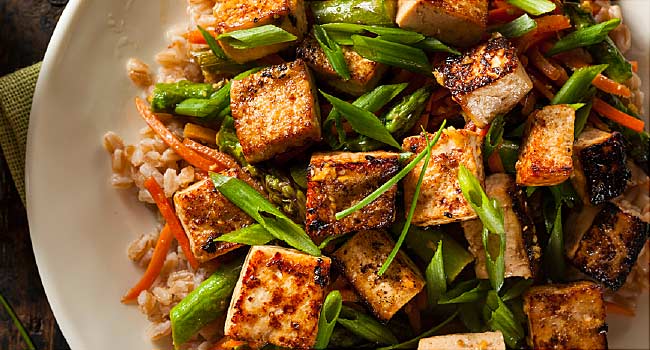Personal trainer in Oxford , Dan Buda talks about importance of protein for our bodies .
As we age, protein is important for keeping up muscle mass to stay active, avoid injury, and support a healthy immune system.
Choosing non-meat proteins in later years can be a good idea for more than just health or ethical reasons. “Many non-meat protein sources are lower in cost, and if you’re on a fixed income, then watching the food budget can be helpful,” says Angela Catic, MD, an assistant professor of internal medicine, section of geriatrics, at Baylor College of Medicine.
Dental issues like missing teeth and dentures can come into play, too — making a piece of steak or hamburger hard to chew. But there are plenty of ways to get protein besides meat. You just have to know what you’re looking for.
Proteins That Pack a Punch
Meatless protein sources that will give you the biggest bang for your buck are called “complete” proteins.
“Complete proteins have the essential amino acids, or building blocks, that the body requires, in adequate amounts,” says Lauri Wright, PhD, a spokeswoman for the Academy of Nutrition and Dietetics and assistant professor of nutrition at the University of North Florida.
Meats are complete proteins, but many plant-based proteins aren’t. It’s good to know the difference and reach for complete proteins when you can. Some non-meat complete proteins are:
Eggs/Milk/Cheese / Soy / Quinoa
As for “incomplete” proteins, you can buddy them up with another protein source to make a total package. “Many traditional food complements work perfectly for this,” Wright says. “Beans and rice, which is a staple of many Hispanic cultures, is a great example of joining two incomplete plant proteins together.”
Foods That Fuel You
Wherever it comes from, it’s best to get protein in small, regular spurts, rather than one big meal. Loading up on your protein all at once won’t give your body the steady stream of nutrients it needs to last throughout the day. “Your protein intake needs to be spread out through the day — about 25 to 30 grams with each meal,” says Catic.
You don’t have to do a complete menu overhaul to raise your daily protein, says Catic. “It can be as easy as having a peanut butter sandwich for a snack or sprinkling flax or chia seeds into cereal or yogurt.”
Think about the foods you already eat, and build from there. Here are some of the best non-meat protein sources:
Eggs: These are nearly perfect proteins, says Wright. “They have almost precise amounts of all the essential building blocks you need.”
And at only 70 calories an egg, you’re not getting too many calories.
Eggs have the added bonus of being easy to make ahead (hard-boil them and keep them in the fridge for a quick snack) and easy to add to foods you already eat, like salad. They can be a simple dinner option, too — cook them up with some veggies to make an omelet, whip up a frittata, or bake them in a pie crust with some spinach and low-fat cheese for a tasty quiche.
Dairy: Look for low-fat options for your protein fix. Cottage cheese, yogurt, and low-fat cow’s milk are all pumped with it. Pour milk on your cereal for breakfast, or have cheese with your snack crackers. You can even slide in some dairy protein for a delicious dessert. “I sometimes encourage people to have frozen yogurt if they enjoy a treat,” says Catic.
Seeds: Quinoa is a complete protein that has all nine essential amino acids. If you’re not familiar with it, think of it like a grain or pasta. Use it in dishes in place of rice or couscous, for example, and you’ll give your dish an automatic protein boost. Also, chia and flax seeds are small enough to sneak into yogurt, cereal, smoothies, or oatmeal without changing the flavor much.
Soy: Tofu might be the first food you think of when you hear the word “vegetarian.” That’s because it’s a common substitute in dishes that typically use meat. Cubed tofu can be cooked and added to salads or burritos in place of chicken. Or for a quick soy snack, steam a bag of edamame — soybeans in pods you can pop into your mouth while they’re still warm.
Greens: Veggies like spinach and kale are an easy way to get a whole host of nutrients, including protein. Add a layer to sandwiches, or fill a bowl and top with your favorite veggies for a healthy salad.
Smoothies can give you your greens, too: Along with fruits, milk, yogurt, or even a dab of peanut butter, you can also throw some spinach into your blender. “Spinach has 5 grams of protein per cup, so it’s not huge, but it’s great because you’re getting other things like vitamin A and calcium and iron,” says Catic.
Beans: Pick a bean, any bean, and you’ve got protein. “Beans are a fabulous source,” says Wright.
And they come with lots of bonuses, like fiber, folate, antioxidants, and vitamins. Beans can beef up soups, or — in the case of chickpeas — be blended into tasty dips like hummus.
Nuts: Peanut butter is a no-brainer when it comes to easy protein for your daily diet. Add a spoonful to your oatmeal, or spread some on whole-grain crackers or fruit. Skip the liquid nuts, though. “I don’t recommend nut milks as a protein source because they don’t have the protein in them that the soy and the cow’s milk do,” says Wright.

